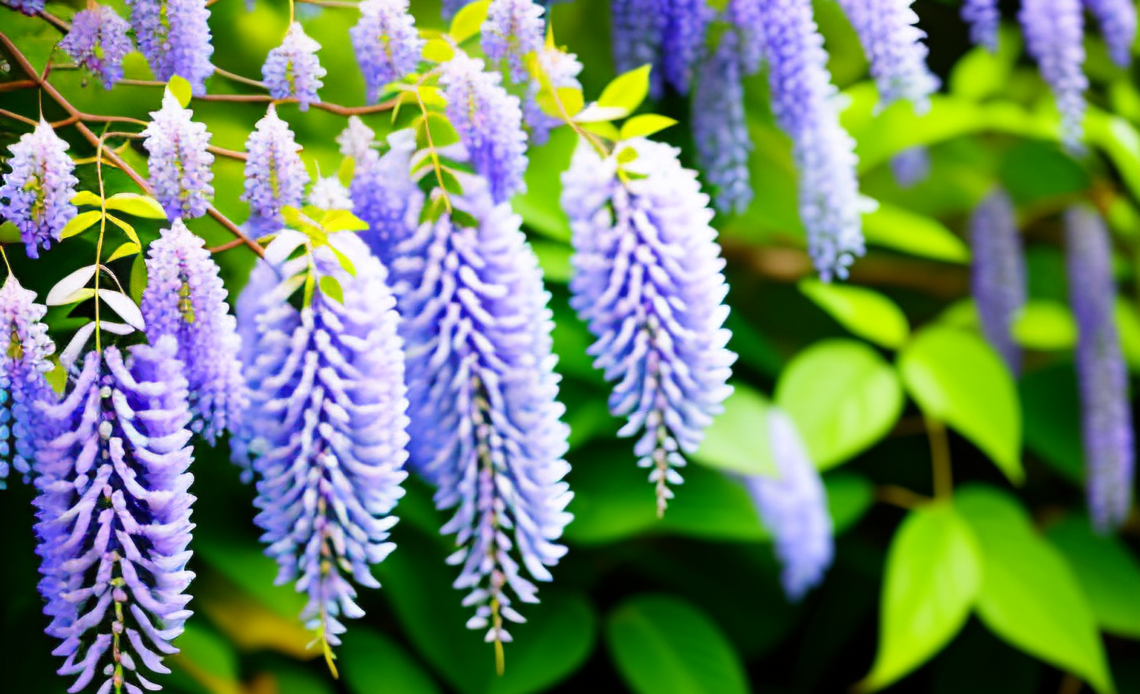
Discover the beauty and versatility of the Blue Moon Wisteria plant and how it can enhance your garden. The Blue Moon Wisteria is a stunning flowering vine that can add a touch of enchantment to any outdoor space. With its cascading clusters of fragrant blue flowers, it creates a captivating display that is sure to impress.
One of the unique characteristics of the Blue Moon Wisteria is its ability to bloom multiple times throughout the year. Unlike other varieties of wisteria, which typically bloom only once in the spring, the Blue Moon Wisteria can produce flowers in both spring and summer, extending the blooming season and providing continuous beauty in your garden.
Caring for the Blue Moon Wisteria is relatively easy, but it does require some attention. It thrives in full sun, so it’s important to choose a spot in your garden that receives at least six hours of direct sunlight each day. The soil should be well-drained and rich in organic matter to ensure proper growth and blooming.
Watering is essential during the establishment period, but once the plant is established, it is relatively drought-tolerant. Regular watering is still necessary, especially during dry periods, to keep the soil moist but not waterlogged. Mulching around the base of the plant can help retain moisture and suppress weed growth.
Supporting the Blue Moon Wisteria is crucial to its growth and overall appearance. It is a vigorous climber that needs a sturdy structure to climb on, such as a trellis, pergola, or arbor. Providing proper support not only helps the vine reach its full potential but also prevents it from sprawling and becoming unruly.
In conclusion, the Blue Moon Wisteria is a captivating plant that can transform your garden into a magical oasis. Its unique characteristics, such as its extended blooming season and fragrant blue flowers, make it a standout choice for any garden. By following the care tips and providing the right support, you can enjoy the enchanting beauty of the Blue Moon Wisteria in your own outdoor space.
Choosing the Perfect Spot

When it comes to planting the Blue Moon Wisteria in your garden, selecting the right location is crucial for its proper growth and blooming. Here are some important considerations to keep in mind:
- Sunlight: Blue Moon Wisteria thrives in full sun, so choose a spot in your garden that receives at least 6 to 8 hours of direct sunlight every day. Without adequate sunlight, the plant may not bloom to its full potential.
- Soil: This enchanting flowering vine prefers well-drained soil that is rich in organic matter. Make sure the soil is loose and fertile, allowing for proper root development and nutrient absorption.
- pH Level: Blue Moon Wisteria thrives in slightly acidic to neutral soil, with a pH range of 6.0 to 7.0. Test the soil in your chosen spot and make any necessary adjustments to ensure the ideal pH level.
- Space: Consider the space requirements of the Blue Moon Wisteria. This vigorous vine can grow up to 25 feet in length, so provide ample space for its sprawling growth. It’s also important to provide a sturdy support structure, such as a trellis or pergola, for the vine to climb and twine around.
- Protection: While Blue Moon Wisteria can tolerate a range of temperatures, it’s best to choose a spot that offers some protection from strong winds and frost. This will help prevent damage to the delicate blooms and ensure the longevity of the plant.
By carefully selecting the perfect spot for your Blue Moon Wisteria, you can ensure its proper growth and blooming, creating a stunning focal point in your garden.
Planting and Care Tips
Planting and caring for the Blue Moon Wisteria requires careful attention to detail to ensure its successful growth and blooming. Follow these step-by-step instructions to plant and care for this enchanting flowering vine:
- Choose the right location: Select a spot in your garden that receives full sun to partial shade. The Blue Moon Wisteria thrives in well-draining soil, so make sure the chosen area has good drainage.
- Prepare the soil: Before planting, prepare the soil by loosening it and removing any weeds or grass. Mix in organic matter, such as compost or well-rotted manure, to improve fertility and moisture retention.
- Planting: Dig a hole that is twice as wide and deep as the root ball of the Blue Moon Wisteria. Place the plant in the hole, ensuring that the top of the root ball is level with the soil surface. Backfill the hole with soil and gently firm it around the plant.
- Support structure: As the Blue Moon Wisteria grows, it will need a sturdy support structure to climb on. Install a trellis, arbor, or pergola near the plant to provide it with the necessary support.
- Watering: After planting, water the Blue Moon Wisteria thoroughly to settle the soil. Keep the soil consistently moist, but not waterlogged, during the growing season. Water deeply at least once a week, or more frequently during hot and dry periods.
- Fertilizing: Feed the Blue Moon Wisteria with a balanced fertilizer in early spring, before new growth begins. Follow the package instructions for the appropriate dosage and application method.
- Pruning: Prune the Blue Moon Wisteria in late winter or early spring to control its size and shape. Remove any dead or damaged branches and cut back the side shoots to encourage new growth and abundant flowering.
By following these planting and care tips, you can ensure that your Blue Moon Wisteria thrives and graces your garden with its stunning blooms. Remember to provide it with the right conditions, support, and maintenance for a healthy and vibrant plant.
Pruning and Training Techniques

Pruning and training the Blue Moon Wisteria is essential to maintain its stunning display and prevent overgrowth. By shaping and controlling the vine, you can maximize its beauty and ensure its healthy growth. Here are some techniques to help you achieve this:
- Pruning: Regular pruning is necessary to maintain the shape and size of the Blue Moon Wisteria. Start by removing any dead or damaged branches, as well as any suckers that may appear at the base of the plant. Prune back long, unruly shoots to encourage bushier growth and more abundant blooms.
- Training: As the Blue Moon Wisteria grows, it will need support to climb and showcase its cascading flowers. Use a trellis, pergola, or other structures to guide the vine’s growth. Gently tie the stems to the support using soft garden twine or plant ties. Train the vine to follow the desired shape, such as an arch or a fan pattern.
- Regular Maintenance: Throughout the growing season, continue to monitor the vine’s growth and make adjustments as needed. Remove any side shoots that may divert energy from the main stems. Trim back excessive growth to maintain a balanced and aesthetically pleasing shape.
Remember to prune and train the Blue Moon Wisteria during its dormant season, typically in late winter or early spring. This will minimize the risk of damaging new growth and ensure the best results. With proper pruning and training, your Blue Moon Wisteria will flourish and create a breathtaking display in your garden.
Dealing with Pests and Diseases
When it comes to the Blue Moon Wisteria, it’s important to be aware of the common pests and diseases that can affect this enchanting flowering vine. By understanding these potential threats and knowing how to prevent and treat them, you can ensure the health and vitality of your plant.
One common pest that may target the Blue Moon Wisteria is aphids. These tiny insects can suck the sap from the plant, causing stunted growth and distorted leaves. To prevent aphids, regularly inspect your plant and remove any infested leaves or stems. You can also introduce natural predators like ladybugs to help control aphid populations.
Another potential pest is the wisteria borer, which lays its eggs on the stems of the plant. The larvae then bore into the stems, causing damage and weakening the plant. To prevent wisteria borers, keep your Blue Moon Wisteria healthy and well-maintained. Prune any dead or damaged branches and monitor the plant for signs of infestation.
In terms of diseases, one to watch out for is powdery mildew. This fungal infection appears as a white powdery coating on the leaves and can hinder the plant’s growth and overall appearance. To prevent powdery mildew, ensure proper air circulation around the plant by pruning any overcrowded branches. If the infection occurs, you can treat it with a fungicide specifically designed for powdery mildew.
Another disease that can affect the Blue Moon Wisteria is root rot. This fungal infection occurs when the plant’s roots are constantly exposed to excessive moisture. To prevent root rot, make sure the soil is well-draining and avoid overwatering. If root rot does occur, you may need to replant the wisteria in fresh, well-draining soil.
By being proactive and taking the necessary steps to prevent and treat pests and diseases, you can ensure that your Blue Moon Wisteria remains healthy and vibrant, allowing you to fully enjoy its enchanting beauty in your garden.
Propagation Methods
Propagation Methods
Propagation is an exciting way to expand your garden and share the beauty of the Blue Moon Wisteria with others. There are two main methods of propagating this enchanting vine: seed propagation and grafting.
Seed Propagation:
One way to propagate the Blue Moon Wisteria is through seed propagation. Start by collecting mature seeds from the plant’s pods. Soak the seeds in water for 24 hours to help with germination. Then, plant the seeds in a well-draining soil mix and keep them moist. It may take several weeks for the seeds to sprout, so be patient. Once the seedlings are large enough, they can be transplanted into individual pots or directly into the garden.
Grafting:
Grafting is another method of propagating the Blue Moon Wisteria. This technique involves combining a desired variety of the plant (known as the scion) with a compatible rootstock. The scion is carefully attached to the rootstock, and over time, they fuse together to form a new plant. Grafting requires some skill and knowledge, so it’s recommended to seek guidance from experienced gardeners or horticulturists.
By exploring these propagation methods, you can create new Blue Moon Wisteria plants and expand your garden with their enchanting beauty. Whether you choose seed propagation or grafting, the result will be a flourishing vine that adds a touch of magic to your outdoor space.
Enhancing Your Garden Design
Enhancing Your Garden Design
Transform your garden into a mesmerizing oasis by incorporating the enchanting Blue Moon Wisteria into your design. This captivating flowering vine can add a touch of elegance and beauty to any outdoor space. To showcase its full potential, consider exploring various structures and ideas, such as trellises and pergolas.
A trellis can provide a vertical support system for the Blue Moon Wisteria, allowing it to climb and cascade gracefully. Choose a sturdy trellis design that complements the overall aesthetic of your garden. As the vine grows, it will weave its way through the trellis, creating a stunning display of vibrant blue blooms.
Another option to enhance your garden design is to incorporate a pergola. This structure not only provides shade and a cozy seating area but also serves as a perfect framework for the Blue Moon Wisteria to thrive. Imagine sitting under a pergola adorned with cascading wisteria blooms, creating a magical and romantic atmosphere.
Don’t limit yourself to these structures alone. Get creative and explore other ideas to showcase the beauty of this captivating vine. Consider using arches, fences, or even a combination of different structures to create a unique and visually stunning garden design.
Remember, the Blue Moon Wisteria will be the star of your garden, so make sure to choose structures and ideas that highlight its beauty and allow it to flourish. With a little imagination and careful planning, you can transform your garden into a breathtaking sanctuary filled with the enchanting allure of the Blue Moon Wisteria.
Enjoying the Blooms
When it comes to the Blue Moon Wisteria, the blooming season is a truly magical time. This enchanting flowering vine produces stunning clusters of blue-purple blooms that are sure to captivate anyone who sees them. To ensure you make the most of this beautiful display, there are a few things you need to know.
Firstly, it’s important to understand when the Blue Moon Wisteria typically blooms. This vine is known for its late spring to early summer flowering period, usually in May and June. During this time, the vine becomes adorned with cascades of delicate flowers, creating a breathtaking sight in any garden.
To maximize the floral display of your Blue Moon Wisteria, there are a few tips you can follow. Firstly, make sure the vine receives plenty of sunlight. This plant thrives in full sun, so choose a location in your garden that gets at least six hours of direct sunlight each day.
Another key aspect of enjoying the blooms is proper pruning. By removing any dead or damaged branches, you can encourage new growth and ensure the vine remains healthy. Additionally, training the vine to grow along a trellis or pergola can help showcase the blooms and create a stunning focal point in your garden.
When it comes to arranging and preserving the blooms, there are endless possibilities. You can create beautiful bouquets to enjoy indoors or use the blooms to decorate outdoor spaces. To preserve their enchanting beauty, consider drying the flowers or pressing them between the pages of a book.
Whether you choose to admire the blooms indoors or outdoors, the Blue Moon Wisteria is sure to bring a touch of enchantment to your surroundings. With a little care and creativity, you can fully enjoy the beauty of this captivating flowering vine.
Companion Planting
When it comes to creating a harmonious garden design, choosing the right companion plants for your Blue Moon Wisteria is essential. By selecting plants that complement its color and growth habits, you can create a visually stunning landscape that will leave everyone in awe.
One great companion plant for the Blue Moon Wisteria is the Clematis. This vine plant features beautiful flowers in various colors, including purple, pink, and white. When planted alongside the Blue Moon Wisteria, the Clematis adds a touch of elegance and creates a striking contrast.
Another excellent choice is the Rose. With its vibrant colors and intoxicating fragrance, the Rose complements the Blue Moon Wisteria perfectly. Planting roses near the wisteria vine adds a romantic and enchanting element to your garden.
If you’re looking for a ground cover option, consider planting the Creeping Phlox. This low-growing plant produces a carpet of colorful flowers that can provide a beautiful backdrop for the Blue Moon Wisteria. The combination of the cascading wisteria blooms and the vibrant phlox flowers creates a captivating display.
In addition to these companion plants, you can also consider including other flowering vines such as the Honeysuckle or the Morning Glory. These plants not only add more color and texture to your garden but also attract pollinators, creating a lively and vibrant environment.
By carefully selecting companion plants that complement the Blue Moon Wisteria, you can create a harmonious and visually stunning garden design. Whether you choose vines, ground covers, or other flowering plants, the combination of these plants will enhance the beauty of your wisteria vine and create a truly enchanting landscape.
Blue Moon Wisteria Varieties
When it comes to the Blue Moon Wisteria, there are several varieties to choose from, each with its own unique characteristics. Exploring these different varieties will help you find the perfect one for your garden.
Flower Color: One of the key variations among Blue Moon Wisteria varieties is the color of their flowers. While the most common color is a beautiful shade of lavender-blue, you can also find varieties with white, pink, or even violet flowers. Consider the color scheme of your garden and choose a variety that complements it.
Size: Another factor to consider is the size of the Blue Moon Wisteria. Some varieties are more compact, making them suitable for smaller gardens or containers, while others can grow larger and create a more dramatic impact. Take into account the available space in your garden and choose a size that fits your needs.
Growth Habits: Different varieties of Blue Moon Wisteria may have varying growth habits. Some varieties are more vigorous and can quickly cover a trellis or pergola, while others have a more restrained growth pattern. Consider how much maintenance and pruning you are willing to do and choose a variety that aligns with your preferences.
By exploring the different Blue Moon Wisteria varieties, you can find the perfect one that matches your garden’s aesthetic and meets your specific requirements. Whether you prefer a certain flower color, need a compact size, or want a particular growth habit, there is a variety out there that will enhance the beauty of your garden.

